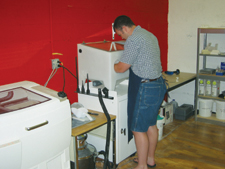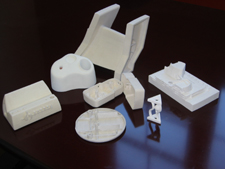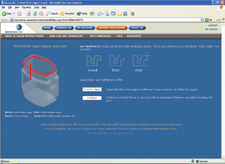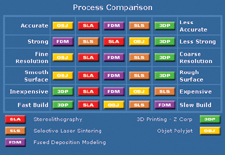Now It’s Your Turn
Taking the next step in outsourcing your rapid prototypes.
Latest News
September 1, 2004
By Glenn Hartwig

OK, so you’re intrigued with the idea of outsourcing your rapid prototypes. Youlike the idea of handing off the MCAD-to-CAM interoperability problem to someoneelse but you also don’t want to waste time and money going back and forth overand over. How do you approach all this?
First off, ask questions and figure out who takes responsibility for what. Youshould inquire about what methodologies the service bureaus use to address interoperability.That is, do they convert your CAD files to STL (stereolithography), which allRP (rapid prototyping) machines require for input, and do they also tweak yourfiles or massage them in any way to make sure the file is something they can use?
According to Steve Stewart, president, Protogenic, Inc., Westminster, CO, thisis an area that demands some careful thought. Says Stewart, “We do convert Pro/Eand UG files to STL ]stereolithography], but we really prefer the STL file sothat our customers can see on their screens what they will be getting.”
As far as cleaning up or making changes to a customer’s file, however, he pointsout that, “We do not ‘fine-tune’ their files, as they should get exactly whatthey have designed, in our opinion. We do point out to them features that aretoo small to build due to process limitations (small text, thin walls, etc.),when we send the quote.”
On this same issue, Patrick Barrett, president, Sherpa Design, Inc., in Portland,Oregon, says, “Once the file is in STL format, we are limited on the changes thatcan easily be made, so we also like to request a neutral file format or the nativePRT file.” Changes can be made, in consultation with the customer, but Barrettindicates that this should be considered an extra. “We have multiple CAD systemsat our disposal (Unigraphics, Pro/E, SolidWorks, CATIA) so we can offer additionalmodeling services as changes are needed,” explains Barrett.
 Rick Chin, president, Xpress3D, Inc., Shrewsbury, MA, acknowledges the customer’sresponsibility in generating the STL file but believes that the service bureaucan help out by looking for obvious errors. He also notes that the type of MCADsystem makes a difference. For example, he says, “To ensure the part is builtcorrectly on the RP machine, the STL file must be watertight. When the file comesfrom a feature-based solid modeler like SolidWorks and Pro/E, the file is prettymuch guaranteed to be watertight. When the file comes from a surfacing system,then there is a good chance there may be gaps in the data,” (i.e., not watertight).
Rick Chin, president, Xpress3D, Inc., Shrewsbury, MA, acknowledges the customer’sresponsibility in generating the STL file but believes that the service bureaucan help out by looking for obvious errors. He also notes that the type of MCADsystem makes a difference. For example, he says, “To ensure the part is builtcorrectly on the RP machine, the STL file must be watertight. When the file comesfrom a feature-based solid modeler like SolidWorks and Pro/E, the file is prettymuch guaranteed to be watertight. When the file comes from a surfacing system,then there is a good chance there may be gaps in the data,” (i.e., not watertight).
Then there’s the issue of what designers, mechanical engineers, and firms shouldknow about the rapid prototyping service business to succeed in their relationshipswith the service bureaus.
According to Paul Edwards at 3T RPD Ltd., Telford, UK, “It is important thatdesigners have a basic understanding of what is involved in turning their STLfile into a 3D prototype. Many customers believe we take their CAD file, pusha button on a machine, and ‘hey presto’ the part is built a few hours later. Thisis not the case. There is at least half a day’s worth of CAD preparation beforea machine starts building.” He goes on to point out that, “As we are talking aboutlayer-based manufacturing, the build orientation will greatly affect quality fromboth an aesthetic and functional aspect. Once a machine has finished building,all parts need to cool down naturally to prevent them from warping. Again, insome cases, this can add up to two days to the overall lead-time.”
Protogenic’s Steve Stewart adds, “Designers and engineers will succeed best ifthey understand the limitations of the processes and materials, and provide servicebureaus with good, unambiguous data. Bad files, files that require intermediateconversions, or even native CAD files that have errors in them, all stop or slowdown the successful completion of the process.”
 Be Curious
Be Curious A final issue for the designer/ engineer to consider might be summed up as, Whatshould consumers look out for when seeking such a service? How do they know ifthey can trust someone else’s grasp of the technology?
Patrick Barrett at Sherpa Designs presents these insights. “Taking some timeupfront to help with material or infiltrant selection based upon the end functiondesired will deliver the best prototypes. Do they really need a prototype withtolerance of 60.001 inch at this phase of development or would a lower-cost alternativemake more sense? If it’s a fit check on a tight assembly, then you need a higher-endmethod like SLA ]stereolithography apparatus], whereas a marketing review of threedifferent alternatives probably doesn’t justify the cost or time expense for SLAand FDM ]fused deposition modeling].”
For Steve Stewart, customers should be on the lookout for some basic tip-offs.“They should look for experienced providers, just like anything else,” he says.“They should look for service bureaus that QC ]quality control] their work, andguarantee tolerances—the majority of service bureau’s do not measure their parts,and most do not guarantee their work, as hard as that may be to believe.”
How can you trust someone’s grasp of the technology? For Paul Edwards “Customersare right to question someone else’s grasp of the technology, especially if thebureau offers a whole range of different technologies. At 3T, we decided to specializein just the SLS ]selective laser sintering] technology to give our customers confidencethat we are experts in this field.”

Be Confident
So, when it comes to rapid prototyping service bureaus, ask lots and lots ofquestions, find somebody you can work with, don’t expect magic, be willing tospend the time to get the details straight, and be meticulous about the data youprovide. That all sounds like the kind of stuff most of us do when approachingany important task, so it wouldn’t seem to be an extra burden here.
Still, the thing to remember is that RP service bureaus will lessen your headaches(as well as your overhead) but personal involvement on your part is never goingto go away completely.
Glenn Hartwig has been writing on technology issues for more than 25 years. You can send Glennyour comments by clicking here. Please reference “No It’s Your Turn” in your message.
Subscribe to our FREE magazine, FREE email newsletters or both!
Latest News
About the Author
DE’s editors contribute news and new product announcements to Digital Engineering.
Press releases may be sent to them via [email protected].






